Has XaaS Changed Business Models?
Share this article

The quick answer is yes, absolutely – XaaS has transformed business. The long answer is that it depends on whether or not you think XaaS is really that new. In reality, businesses have been outsourcing functions, services and support for decades. XaaS hasn’t changed that, it’s just made it easier than ever, and that simplicity makes a difference.
However, this all begs the question – what is XaaS? Here, we’ll explain just that and then dive into the details of how XaaS should impact your thinking when it comes to building your own business and your go-to-market strategy. Let’s get started.
What is XaaS?
XaaS (pronounced “Anything-as-a-Service”) describes a general trend towards purchasing service-based outcomes rather than the component pieces required for that service. For example, partnering with an on-demand customer service outsource provider rather than recruiting and maintaining an in-house customer service team.
The phrase XaaS is clearly related to more established terms like SaaS (Software-as-a-Service), IaaS (Infrastructure as a Service), and PaaS (Platform-as-a-Service). XaaS extends this concept to physical services, but remains directly related to these different cloud computing models in three main ways:
- It’s subscription based: XaaS is always billed on rolling contracts based on what you use. That could be per user or total use. However, what makes it different from traditional outsourcing is the true on-demand nature that it shares with software-led businesses.
- It’s digital-first: XaaS models generally take advantage of digital communication and delivery channels to lower overheads and simplify relationships. This makes it easy to get started and allows XaaS providers to more effectively operate as an integrated part of your business.
- It removes complexity: The whole idea behind PaaS, IaaS and SaaS is to provide hassle-free IT foundations that you can use to then focus solely on outcomes. This is exactly what XaaS enables, just applied to a wider range of solutions.
Side note: XaaS is a B2B term. However, it’s also connected to broader B2C trends in consumption. For example, Uber (Transport-as-a-Service), Netflix (Entertainment-as-a-Service), Airbnb (Property-as-a-Service), Just Eat (Food-as-a-Service) are all as-a-service models. Arguably, a big part of what we are seeing today is the migration of simpler, subscription-based and frictionless buying experiences from consumer markets into B2B relationships. We’re all used to getting everything on-demand in our personal lives, it’s no wonder business needs to keep up.
How XaaS transforms business strategy
XaaS is all about enabling your company to focus on its core expertise and create efficiency within your business. By aligning your focus on what really matters, small businesses can get up and running faster, and larger companies can scale with ease – reducing opportunity costs. Not only is it possible to quickly access what’s needed, but there are also fewer things distracting you from what’s really important, i.e. growing your business. Examples of XaaS offerings that have made a big impact include:
- Office-as-a-Service: WeWork and other flexible office space companies exploded in popularity during the 2010s. Nowadays it’s a common and very popular service. WeWork themselves cater to over 600,000 members across the world.1 Companies like this offer small businesses the ability to access meeting rooms and offices when needed, keeping down overheads and enabling increased professionalism to startups. Larger companies can access local offices in new locations, and large and small businesses benefit from full office amenities provided as-a-Service – reducing the number of things to think about.
- Marketing-as-a-Service: XaaS offerings extend to the entire specialised functions of your business. Marketing is an excellent example of a core supporting capability that often falls outside of the expertise of small and large companies alike. By partnering with Marketing-as-a-Service (MaaS) providers, businesses can access the expertise of an in-house marketing team on-demand. This is critical to support growth with sophisticated strategies at every stage of development.
- Customer Service-as-a-Service: Customer service is another critical support function that is difficult for many businesses to manage. Far too often growth can end up stalled by an inability to support new customers. As-a-Service customer service support provides a way around that problem while also freeing up resources to focus on acquiring customers in the first place.
- IT-as-a-Service: Of course, accessing IT services as-a-Service still falls within the category of XaaS and remains a critical and popular example of how service-based offerings transform business models. Beyond SaaS, PaaS, IaaS and other cloud-computing options, OPEX (operating expenses) models are a popular way to access hardware – especially when supported by managed service providers. This allows faster access to critical equipment at lower upfront costs and removes the need to think about maintenance.
Do you want to discover how MaaS can unlock your businesses growth potential?
Find out by booking your Free Growth Audit
By using XaaS, businesses can save costs by taking advantage of flexible, subscription-based, ‘pay-as-you-use’ models that most XaaS providers offer. This allows your business as a whole to be flexible and only spend your budget on what’s needed. XaaS is a solution for companies looking to access specialised skills on-demand whilst also requiring it to be scalable to their needs.
How XaaS impacts go-to-marketing strategy
Not only should you take advantage of XaaS when building your business, but you should also consider how you can adopt components of XaaS into your go-to-market strategy to improve your position in the market. Consider how you can:
- Make your product easy to ‘try and buy’: This allows customer engagement on how the product or service can be shaped after a trial period or taster. Which can then improve the full product or service and retain those initial customers trying the product out.
- Offer a subscription-based model: Using a subscription-based model can lower the costs for acquiring new customers and help retain existing ones. Usually, the signing up of a subscription implies repeat business, which means that your marketing spending on those existing customers can be focused elsewhere in the company. Such as improving on the product or service at hand.
- Reduce the complexity of your product: Streamlining what your product is and making it easy to understand and accessible on-demand is core to XaaS. This allows your product to reach more customers without unnecessarily explaining your service and instead generate leads that become buyers.
Whether or not it’s new, XaaS is important
Labour specialisation has been a defining trend since the dawn of the agricultural revolution. This trend has since expanded in the modern world of businesses via methods such as assembly lines in factories. XaaS has essentially taken this and streamlined the idea further. Incorporating on-demand service and providing outsourcing options and flexibility to your product or service just makes sense in the modern world.
Building a frictionless and simple buying service, which many B2C businesses use, can easily be transitioned into the B2B market – and that is exactly what XaaS is doing. It’s nothing new or groundbreaking. But by allowing the ease of use, affordable pricing structures, and most importantly, on-demand service shows that XaaS is here to stay and is only going to grow stronger.
For more information on XaaS, the ‘as-a-service’ model, and many more valuable tips, you can read our many other blogs and articles that cover various topics.
At Gripped, we work with B2B businesses, helping shape their growth and strategy. We deliver ongoing digital sales and marketing strategies to improve your business wherever and however we can. Do you want to discover how MaaS can unlock your growth potential? Book Your Free Growth Audit today.

Reach Your Revenue Goals. Grow MRR with Gripped.
Discover how Gripped can help drive more trial sign-ups, secure quality demos with decision makers and maximise your marketing budget.
Here's what you'll get:
- Helpful advice and guidance
- No sales pitches or nonsense
- No obligations or commitments



Book your free digital marketing review
Other Articles you maybe interested in
What B2B SaaS Founders Want from their CMOs – Thoughts and Analysis 2025
B2B SaaS founders are typically driven by product innovation and business growth. They launch companies to solve pressing customer problems and capture new markets, which makes achieving product-market fit and scaling revenue top priorities. In founder surveys, hiring the right team consistently ranks as a major concern – for example, First Round Capital found that…
B2B Demand Generation: Should You Adopt This Strategy in 2025?
Discover the essential tactics and strategies for B2B demand generation in this comprehensive guide.
A Guide to the Top 10 Marketing Agencies for B2B SaaS Companies: A Comprehensive Comparison Guide
The B2B SaaS landscape is booming—and it’s never been more challenging to break through the noise. Between new entrants, accelerating product cycles, and sky-high expectations from digitally savvy buyers, marketing your SaaS offering effectively requires a nuanced, tech-first approach. That’s where specialised marketing agencies for B2B SaaS companies come in. Unlike generalist agencies, these specialised…


